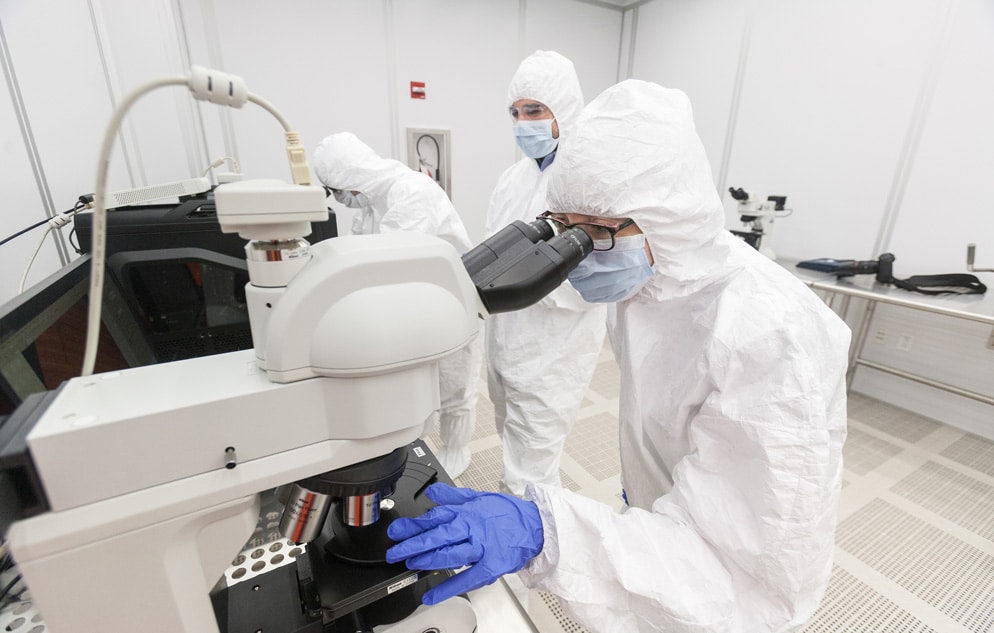Creating an Integrated Science Network
The ASRC operates as the nucleus of a University-wide science enterprise, fostering the development of an integrated research network that brings together faculty, students, and post-doctoral fellows from The Graduate Center and CUNY’s colleges across the five boroughs. Twenty faculty, including directors for each of the five initiatives, form the Center’s core faculty. Each has an appointment at a senior college and is being joined by current CUNY faculty who are using the center’s facilities to advance the scope and scale of their work.

Additional faculty bring specialized research pursuits that not only help energize and define the ASRC, but the next generation of science in New York City. Like many of the CUNY researchers who are already part of the center, these faculty are drawn by the opportunity to work in an innovative, entrepreneurial research environment.
Here’s how a ground-breaking collaboration might work: On the neuroscience floor, researchers are engaged in mapping the brain’s biochemical circuitry to solve complex puzzles such as Alzheimer’s disease. These neuroscientists then join forces with their colleagues on the nanoscience floor, who are working with matter on a molecular scale to make advances that might lead to new medical treatments. The nanoscientists, in turn, discover collaborations on the photonics floor, where researchers are developing methods of using light to detect bioterror bacteria—or diagnosing cancer without a biopsy. Furthermore, researchers throughout the center might find opportunities for partnership on the structural biology floor, where biologists, chemists, physicists and engineers come together to push the frontiers of applied research in all life sciences.
To make this ambitious concept work, initiative research directors must be world-class scientists as well as leaders—those doing their own research at a very high level and also with the talent to bring faculty together. They are expected to develop collaborations within CUNY, but also to extend to research partnerships with peer institutions in New York and across the country.
Each director has an international reputation for excellence in her or his primary area, but also for thinking broadly and collaboratively across disciplines to solve the most challenging questions in their fields.
Environmental Sciences: Charles J. Vörösmarty
The team that Dr. Vörösmarty has assembled is exploring the most diffuse threats to human health—worldwide air and water issues, climate and weather, and the physical world’s role in spreading disease. The initiative includes a rooftop observatory where sophisticated sensing devices collect and analyze earth and atmospheric data from satellites. And the environmental team is working on an array of research related to the biomedical interests of the center’s four other teams.
Structural Biology: Kevin H. Gardner
Dr. Gardner brings together several labs working at the intersection of biology, chemistry and physics to examine the large molecules that drive most of the functions of cells. Dr. Gardner is an expert in the use of nuclear magnetic resonance (NMR) spectroscopy to study how cells sense and adapt to the environments around them—research that can lead to applications from drug discovery to bioengineering.
Nanoscience Initiative: Rein Ulijn
Dr. Ulijn, a rising young scientist with an international reputation for inventiveness, is leading a dynamic research team that studies matter on a molecular scale from 1 to 100 billionths of a meter. Nanoscience is a major source of important scientific developments, creating extraordinary new materials and devices with a broad range of applications in fields ranging from biomedicine to food science and green energy.
Neuroscience: Patrizia Casaccia
Dr. Casaccia, whose academic research background is tempered with an accomplished background in medical research from her time at Mount Sinai’s Icahn School of Medicine, focuses on glial biology with an emphasis on examining the effect of environmental exposure on brain health and disease. Her research will provide a link between particles measured in nanometers and even femtometers—those studied by the Structural Biology Initiative—and large geographical distances, as researched by the Environmental Sciences Initiative.
Photonics Initiative: Andrea Alù
Dr. Alù is a renowned engineer and photonics researcher and is best known for his breakthroughs in invisibility cloaking, or making objects transparent to incoming microwave signals. He realized the first freestanding three-dimensional invisibility cloak. He also developed the first nonreciprocal acoustic circulator — or one-way sound device. His discoveries in metamaterials and plasmonics have broad implications for a range of sectors, including defense, communications, medical imaging, acoustics, mechanics, and robotics.
